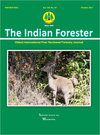Earthquake Early Warning through Abnormal Animal Behaviour
DOI:
https://doi.org/10.36808/if/2017/v143i10/119348Keywords:
Bureau of Indian Standards (BIS), Indian Meteorological Department (IMD), U.S. Geological Survey (USGS).Abstract
Earthquake is one of the most destructive natural hazards causing destruction. However, there is no early warning and forecasting system in place unlike cyclones, floods and tsunami. It is usually predicted seconds before it strikes through instruments installed for this purpose when managing the destruction is not possible. Animals behaving strangely which is not usually normal before an earthquake have been reported. There is need to standardise this abnormal animal behaviour in such a way that it always gives uniform results and if need be in linking with instruments so as to consider it as a reliable and sure early warning before the earthquake strikes. This is urgently required so as to reduce risks that cause loss of lives and properties.References
Agarwal P.N. (1991). Engineering seismology. Oxford and IBH Publishing Company Pvt. Ltd. New Delhi.
Allen C. (1976). The Role of animal behaviour in the Chinese earthquake prediction program. In: Abnormal animal behaviour prior to earthquakes.
Armstrong B.H. (1969). Acoustic emission prior to rockbrust and earthquakes. Bull. Seismol. Soc. Am., 59: 1259-1279.
Beadle M. (1977). The Cat: History, Biology and Behaviour. Simon and Schuster. New York, NY, USA.
Bhargava N., Katiyar V.K., Sharma M.L. and Pradhan P. (2009). Earthquake prediction through animal behaviour. A review. Indian J. Biomechanics, Special Issue (NCBM) 7-8: 159-165.
Brown D.J. (1996). Interview with Marsha Adams unpublished.
Buskirk R.E., Frohlich K. and Litham G.V. (1981). Unusual animal behaviour prior to earthquakes. Review of possible sensory mechanisms. Rev. Geophy. Space Phy., 19: 247-270.
Chapman S. and Bartels J. (1940). Geomagnetism Vol. 1. Clarendon Press, Oxford.
Evernden J.F. (1976). Abnormal animal behaviour prior to earthquakes. US department of interior geological survey conference I. Convened under the auspices of the National earthquake hazards reduction program, USGS, Menlo Park, CA. 23-24.
George P.C. (2007). Can animal predict earthquake. Tsunami pages of George PC. www.dr.georgepc.com.
Grant R.A. and Halliday T. (2010). Predicting the unpredictable; evidence of pre-seismic anticipatory behaviour in the common toad. J. Zoology, 281: 263-271.
Grant R.A., Halliday T., Balderer W.P., Leuenberger F., Newcomer M., Cyr G. and Freund F.T. (2011). Ground water chemistry changes before major earthquakes and possible effects on animals. Int. J. Environ. Res. Public Health. 8: 1936-1956.
Halasz N. (1990). Vertebrate olfactory system. Akaderniai Kiado: Budapest, Hungary.
Hart B.L. (1977). Olfaction and feline behaviour. Feline Pract., 7: 8-10.
Hatai S. and Abe N. (1932). The response of catfish, Parasilurus ascotus, to earthquake. Proc. Imper. Acd. Japan, 8: 374-378.
Hayakawa M. (2013). Possible electro-magnetic effects on abnormal animal behaviour before an earthquake. Animals, 3: 19-32.
Heffner H.E. (1998). Auditory Awareness. Applied Animal Behaviour Science, 57: 259-268.
Ikeya M., Furuta H., Kajiwara N. and Anzai H. (1996). Ground electric field effects on rats and sparrow: Seismic Anomolous Animal Behaviour (SAABs). Japanese J. Appl. Physics, 35: 4587-4594.
IMD (2014). A report on seismic hazard micozonation of NCR Delhi on 1:10,000 scale center for seismology (Indian Meteorological Department), Minsitry of Earth Sciences, Govt. of India, March 2014, New Delhi. India.
Kirschvink J.L. (2000). Earthquake prediction by Animals: Evolution and sensory perception. Bulletin of the Seismological Society of America, 90(2):103-118.
Lakshmi K.R., Y. Nagesh and Veera Krishna M. (2014). Analysis on predicting earthquakes through abnormal behaviour of animals. Inter. J. Scientific and Engineering Research, 5: 845-857.
Miller T. (1996). Earthquake prediction handbook. Info-Pub.
Musha K. (1957). Jishin Namazu (Earthquake and Catfish). Toyotosho. Tokyo. 208.
Otis L.S. and Kautz W.H. (1985). Biological premonitors of earthquakes; validation study, final report. Office of earthquake studies. US Geological Survey. Menlo Park. CA. Sri. International.
Pease J.W. and Orourke T.D. (1997). Seismic response of liquefaction sites, J. Geotech Geoenvrion. Eng., 123: 37-45.
Shier D., Butler J. and Lewis R. (2004). Hole's Human Anatomy and Physiology, 10th Ed. McGraw-Hill: Boston, MA, USA.
Tong W.K. (1988). Abnormal behaviour and the prediction of earthquakes. Phd. Thesis Northestern Illinois University.
Tributsch H. (1982). When the Snakes Awake: Animals and Earthquake Prediction. MIT Press, Cambridge, Massachusetts. 248.
Downloads
Downloads
Published
How to Cite
Issue
Section
License
Unless otherwise stated, copyright or similar rights in all materials presented on the site, including graphical images, are owned by Indian Forester.





